Key takeaways:
- Wildlife art workshops blend creativity with conservation, fostering community and appreciation for nature.
- Art serves as a powerful tool for raising awareness about conservation issues, inspiring individuals to take action.
- Effective workshop planning involves clear objectives, suitable venues, and fostering participant interaction for a meaningful experience.
- Engaging participants with personal wildlife stories and interactive discussions enhances their connection to conservation themes.
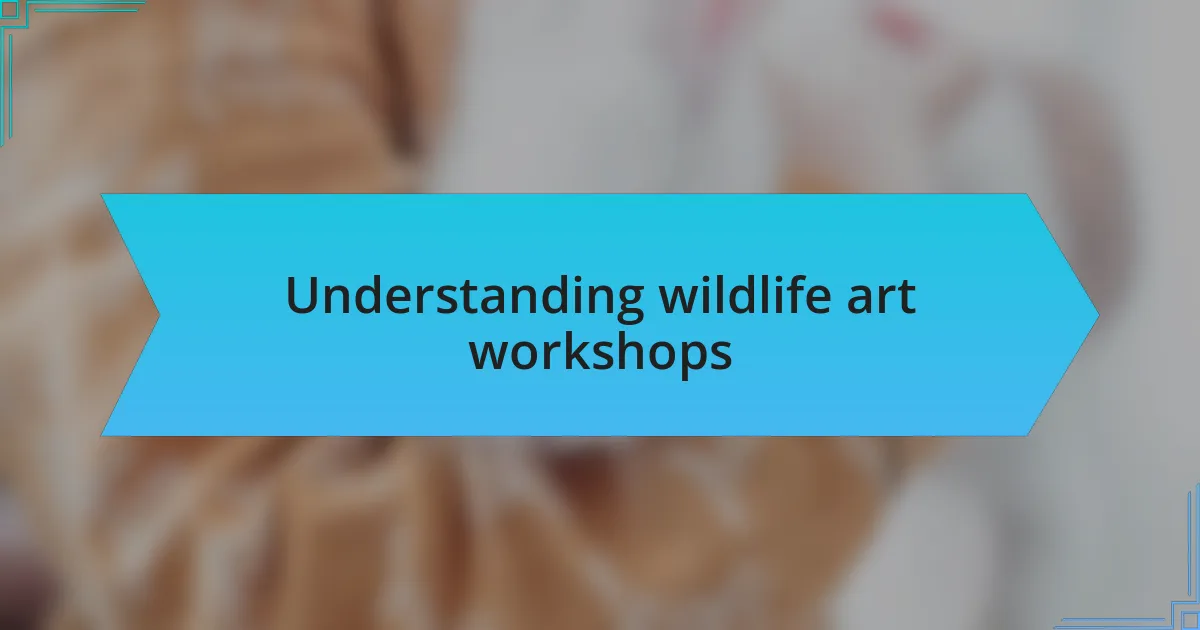
Understanding wildlife art workshops
Wildlife art workshops serve as a unique blend of creativity and conservation, offering participants a chance to express their artistic skills while fostering a deeper connection to the natural world. I remember the first time I picked up a brush to capture the delicate features of a bird; it was more than just art; it felt like I was honoring that creature’s existence. Isn’t it fascinating how art can bridge the gap between our daily lives and the wild lives around us?
These workshops often incorporate education about the species being represented, encouraging participants to understand their behaviors and habitats. During one workshop, a participant shared how learning about the animals helped them appreciate their beauty on a level they never thought possible. Can you imagine translating that newfound respect into something tangible, like a painting or a sculpture? It really adds layers to the creative process.
Moreover, wildlife art workshops create a community of like-minded individuals, sparking conversations about conservation and inspiring action. I’ve witnessed friendships blossom over shared artistic visions, and it’s heartening to see these connections lead to collaborative efforts in safeguarding wildlife. How often do we get the chance to meet others who care as deeply about animals as we do? These interactions can ignite passions that extend far beyond the workshop.
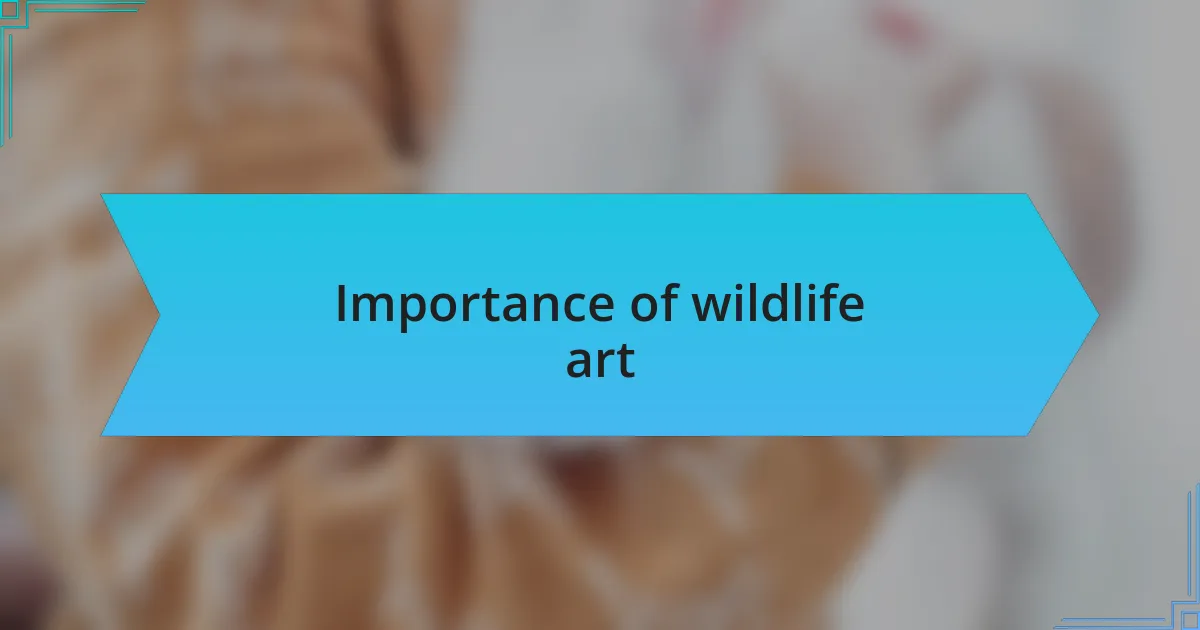
Importance of wildlife art
Wildlife art plays a crucial role in raising awareness about animal conservation and biodiversity. When I create art that depicts endangered species, I feel a sense of responsibility; it’s an opportunity to spotlight their plight and evoke empathy. How often do we consider the emotional connection we can forge through visual representation? It’s a powerful reminder that each brushstroke can tell a story of survival and urgency.
Additionally, wildlife art ignites passion and advocacy among viewers. I recall a moment when a student at one of my workshops became so moved by their painting of a sea turtle that they decided to volunteer with a local ocean conservation group. Isn’t it remarkable how art can inspire individuals to take real-world action? By capturing the essence of these creatures on canvas, we translate their struggle into a voice that demands to be heard.
Ultimately, wildlife art celebrates the beauty and diversity of life on Earth. Each artwork not only showcases the animals but also invites us to reflect upon our shared responsibility in preserving their habitats. I often find myself standing before a finished piece, feeling a wave of gratitude for the chance to advocate for wildlife through creativity. Isn’t it a wonderful thought that something so personal can resonate with others and make a meaningful impact?
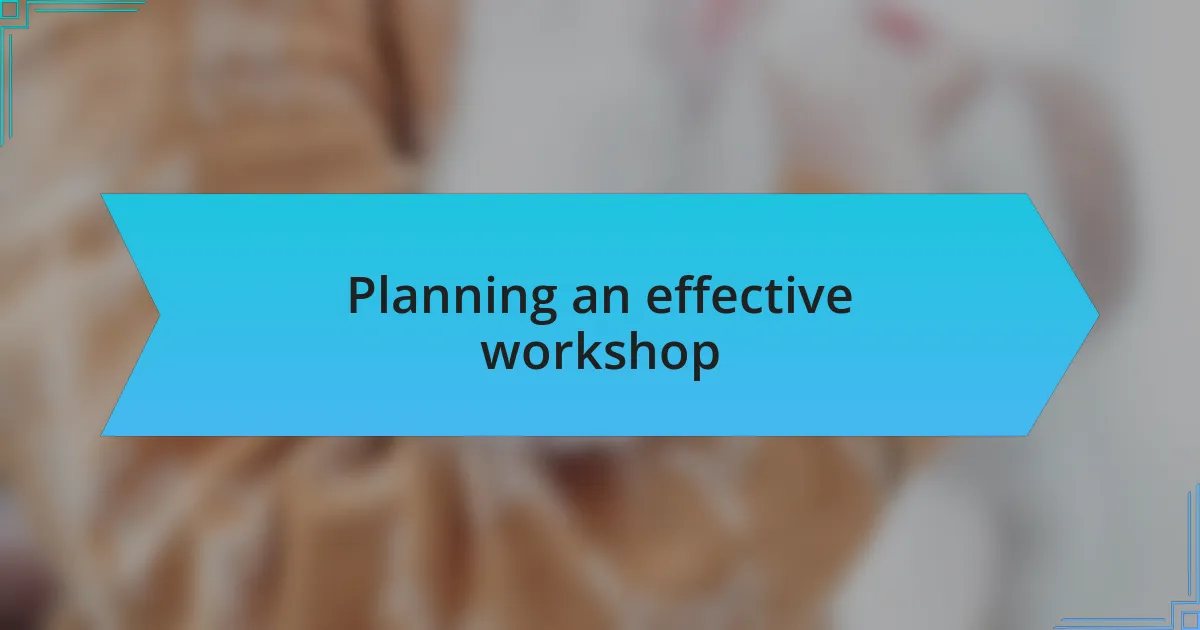
Planning an effective workshop
When planning an effective workshop, I always start by defining clear objectives. Knowing what I want participants to take away helps shape the entire experience. Have you ever walked into a class unsure of its purpose? It can feel disorienting, like wandering through a forest without a map.
Next, I focus on the logistics—choosing an accessible venue, gathering materials, and setting a flexible schedule. I’ve learned that when participants feel comfortable and excited, the creative flow flourishes. I once hosted a workshop in a sunlit studio surrounded by nature; the energy was electric, and creativity bubbled up effortlessly. Isn’t it amazing how the right environment can spark inspiration?
Lastly, I emphasize the importance of fostering interaction among attendees. Encouraging dialogue can transform a one-way presentation into a shared journey. I recall a participant who initially hesitated to share their thoughts but, after some gentle prompting, opened up about their passion for the natural world. Their insights ignited discussions that enriched the entire workshop. Can you feel the difference a supportive community can make in the creative process?
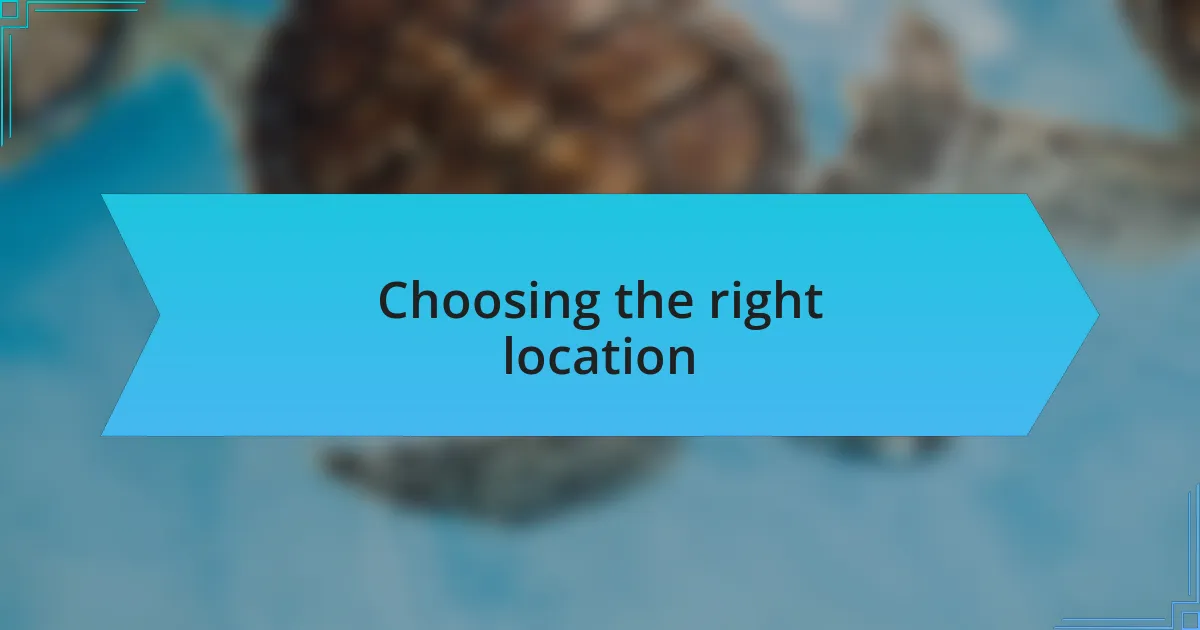
Choosing the right location
Choosing the right location is crucial for a wildlife art workshop. I remember a time when I selected a cozy, rustic art barn nestled in the woods. The peaceful sounds of chirping birds and rustling leaves created an atmosphere where creativity thrived. Can you imagine how much more inspiring it is to paint with nature buzzing all around you?
I also consider accessibility when picking a venue. There was one instance where I chose a location that was challenging for some attendees to reach. It broke my heart to see their excitement dim because of logistics. This experience taught me the importance of ensuring everyone can join in without barriers. Wouldn’t it be wonderful if all participants felt welcome and able to contribute fully?
Finally, I always look for spaces that can accommodate the art-making process comfortably. During a workshop at a local nature reserve, I was thrilled to find an open area with ample room for canvases and easels. We even had a shaded spot for breaks, which allowed participants to step back and reflect on their work. How can we call it a workshop if there’s no space for creativity to unfold?
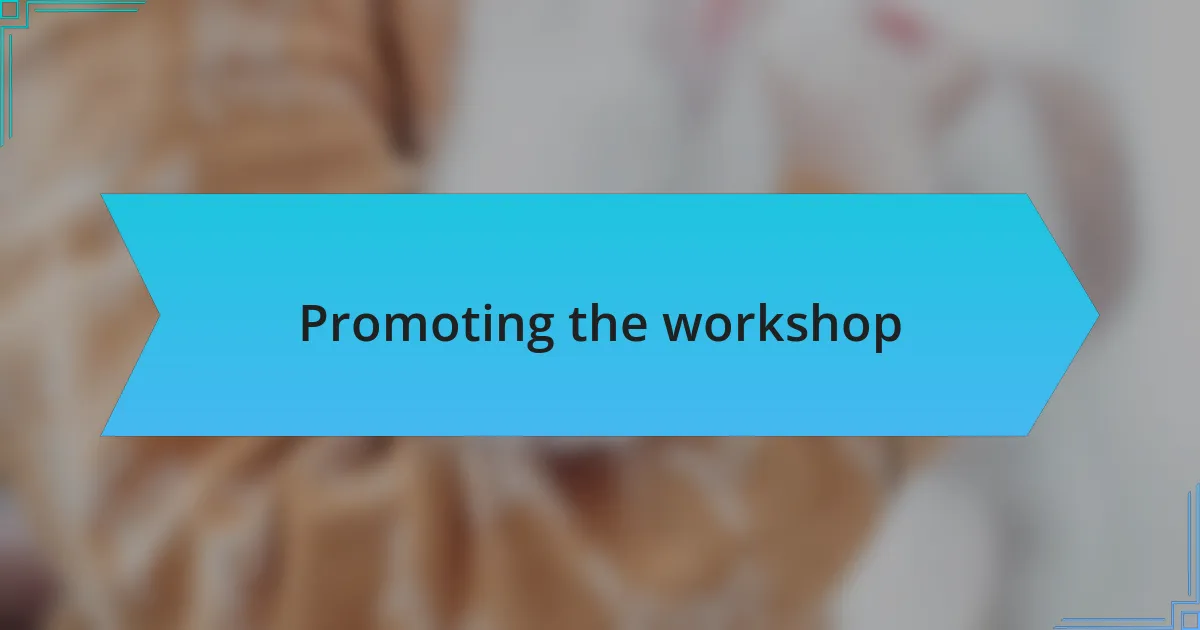
Promoting the workshop
When it comes to promoting the workshop, I found that creating a buzz on social media was incredibly effective. One time, I shared a captivating image of art pieces inspired by local wildlife alongside an invitation to join. The response was overwhelming; attendees began sharing the post, and soon it felt like our workshop had a life of its own. Isn’t it amazing how a single image can ignite excitement and connection within a community focused on animal protection?
I also reached out to local art supply stores and wildlife organizations to build partnerships. During my last workshop, one local shop offered discounts on materials for attendees, which sparked their interest. It was fulfilling to see them eager to participate, knowing they could access quality supplies at a lower cost. How much more encouraging is it for budding artists to feel supported by their local businesses?
Additionally, I crafted engaging flyers that highlighted both the artistic and conservation aspects of the workshop. Distributing these at community events and schools not only spread the word but also educated others on the importance of wildlife preservation through art. I experienced a moment of joy when a student approached me, saying they had never thought about wildlife conservation in this light before. Doesn’t it just warm your heart to inspire others to see the beauty in protecting our natural world?
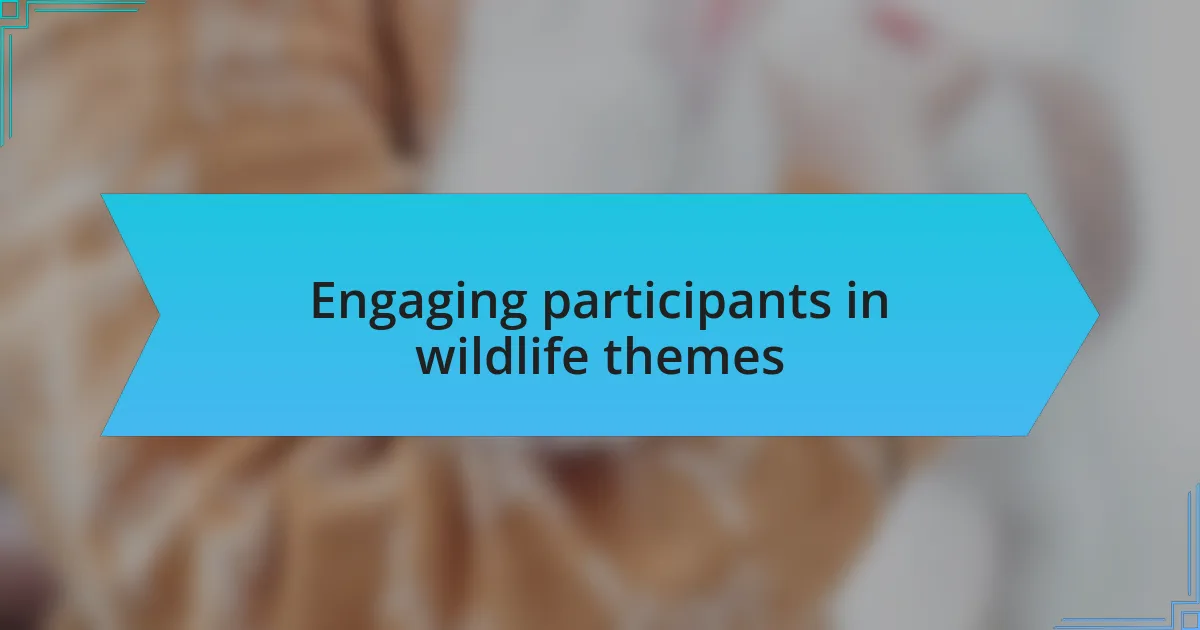
Engaging participants in wildlife themes
Engaging participants in wildlife themes can truly transform their experience. I remember during one workshop, I introduced a session where participants shared their personal encounters with wildlife. The room was filled with laughter and awe as attendees recounted stories of unexpected animal sightings. This shared experience not only connected them to one another but also deepened their appreciation for the wildlife around them. Isn’t it fascinating how our stories can bridge the gaps between us and the natural world?
I also found that incorporating hands-on activities related to wildlife conservation can captivate participants’ attention and stir their passion. For example, we created art pieces that reflected endangered species in our region. As participants painted and learned about these animals, I could see their expressions shift from mere curiosity to genuine concern. It made me realize that once people connect with a cause creatively, their commitment to it often grows stronger. Have you ever experienced the moment when art becomes a vehicle for advocacy?
In addition, I love surprising participants with interactive discussions on wildlife-related issues during the workshop. I often pose thought-provoking questions like, “How can art influence conservation?” Watching their faces light up as they brainstorm solutions was a highlight for me. These discussions not only engaged their minds but also ignited a sense of responsibility towards nature. It’s moments like these that remind me: when we intertwine creativity with pressing issues, we empower individuals to act for the greater good.